Honda Shadow
.jpg) Shadow VT750C Aero in Healesville, Victoria. Photo: Richard Reeve for Yarra Range Council. | |
| Manufacturer | Honda Motor Co. |
|---|---|
| Also called | Shadow 750 Aero |
| Production | September 2003 to present |
| Assembly | Kumamoto and Hamamatsu |
| Predecessor | Shadow VT750CD Deluxe ACE |
| Class | Cruiser |
| Engine | 745cc water cooled 4-stroke SOHC 52° V-twin |
| Bore / stroke | 79.0 mm × 76.0 mm (3.11 in × 2.99 in) |
| Compression ratio | 9.6: 1 |
| Ignition type | Digital transistorized |
| Transmission | Wide-ratio five-speed manual |
| Frame type | Double cradle |
| Suspension |
Front: Telescopic fork Rear: Dual-shock swingarm |
| Brakes |
F: Hydraulic disc R: Mechanical drum R: Hydraulic disk (C-ABS opt.) |
| Tires |
Front: 120/90-17M/C 64S Rear: 160/80-15M/C 74S |
| Rake, trail | 34° 161 mm (6.3 in) |
| Wheelbase | 1,640 mm (64.6 in) |
| Seat height | 658 mm (25.9 in) |
| Fuel capacity | 14 litres (3.1 imperial gallons; 3.7 US gallons) |
| Related |
Shadow 750 Phantom, Shadow 750 Spirit, VT 750 RS |
|
Footnotes / references [1] [2] [3] | |
|
1983 VT750C (or 1984 Canadian model) on avenue Atwater in Montreal | |
| Manufacturer | Honda Motor Co. |
|---|---|
| Also called | NV750 (Japan) |
| Production | December 1982 through 1988 |
| Successor | Shadow VT750C2 ACE (1997) |
| Class | Cruiser |
| Engine | Water cooled 4-stroke SOHC 45° V-twin |
| Bore / stroke |
1983: 79.5 mm × 75.5 mm (3.13 in × 2.97 in), disp. 749.5cc 1984-87: 76.5 mm × 75.5 mm (3.01 in × 2.97 in), disp. 694.5cc 1988: 79.5 mm × 80.6 mm (3.13 in × 3.17 in), disp. 798cc |
| Compression ratio | 9.8: 1 ('83), 9.6: 1 ('84-87) |
| Ignition type | Full transistor |
| Transmission |
1983-87: 6-speed manual, 1988: 4-speed manual |
| Frame type | Double cradle |
| Suspension |
Telescopic front fork, twin-shock rear swingarm |
| Brakes |
Front 1983-85: Double disk, Front 1986-88: Single disk Rear 1983-88: Drum |
| Tires |
Front: 110/90-19 62H Rear: 140/90-15 70H |
| Rake, trail |
1983-85: 32° 139 mm (5.5 in) 1986-87: 33°10' 156 mm (6.1 in) |
| Wheelbase |
1983-85: 1,525 mm (60.0 in) 1986-88: 1,605 mm (63.2 in) |
| Seat height |
1983-85: 760 mm (29.9 in) 1986-87: 710 mm (28.0 in) |
| Fuel capacity |
1983-85: 12.5 litres (2.7 imperial gallons; 3.3 US gallons) 1986-87: 12.0 litres (2.6 imperial gallons; 3.2 US gallons) |
|
Footnotes / references [4] [5] [6] [7] | |
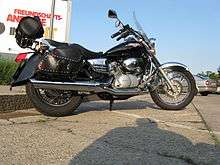
The Honda Shadow refers to a family of cruiser-type motorcycles made by Honda since 1983. The Shadow line features motorcycles with a liquid-cooled 45 or 52-degree V-twin engine ranging from 125 to 1,100 cc engine displacement. The 250 cc Honda Rebel is associated with the Shadow line in certain markets.
History
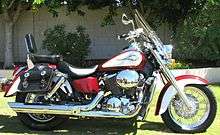
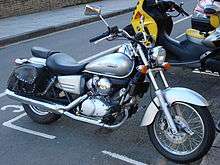
In 1983, Honda introduced the Shadow series of motorcycles in an attempt to address the needs of the American cruiser market with the VT500c and VT750c. However, due to tariff restrictions in the United States on imported Japanese bikes over 701 cc, the VT750c was reduced to 700 cc in 1984 and was sold as the Vt700c. In 1985, the tariff was lifted and the line soon expanded to an 1,100 cc bike the VT1100c. The VT750c was replaced by an 800 cc version the VT800c in 1988.[5]
The VT600c was launched in 1988 as Honda's new entry level Shadow though still slotted above the Honda Rebel. The line changed little until the introduction of the 750 cc Honda Shadow Ace in 1997. From 2000 to 2007, the Honda Shadow Sabre replaced the VT1100 until the 1,100 cc class was discontinued in favor of the new VTX line, specifically the 1,300 cc offering known as the VTX1300. As of 2011, the Shadow brand has been limited to a single 750 cc cruiser available in Spirit, Aero, Phantom, and RS trims. All other offers are known under the VTX or Rebel brands.
The RS and Phantom are the 2 latest additions to the 750 cc line-up from year 2010. Both are Fuel injected. Shadow RS recalls a flat track racing bike with chain drive, a 'peanut' style gas tank and a slightly higher seat height ( 29 inches ) with foot pegs less forward than conventional cruisers ( meaning a more standard seating position). Phantom is more like a conventional cruiser in ergonomics.
Models
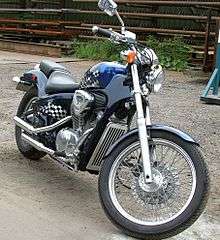
125 cc Class
The Honda 125 is mainly for the UK and Europe market, as it fits within the restrictions placed on learner drivers in the UK and the light motorcycle license in Europe. It also has a chain drive instead of a shaft drive seen on the larger engined bikes. Sales ended in 2009.
500 cc VT Class
The 500cc "VT500C" introduced in 1983 featured chrome side covers and black engine covers. The headlight was chrome and rectangular and had a single horn. The engine was the Honda VT500, a 491 cc (30.0 cu in) OHC three-valve, liquid cooled V-Twin with a six-speed, shaft drive transmission.
In 1984, The "VT500C' was featured include the fuel tank and rear fenders painted the same. The front fender is chrome and this year the side covers and engine covers were painted black. The headlight was chrome and rectangular and there was a single horn. The engine is virtually the same as the 1983 model.
The 1985 "VT500C" had round and chromed headlamps. This model continued with the dual horns. A two piece seat with an integrated backrest was incorporated. Starting this year, the engine covers were polished chrome and the fins enlarged. The "Honda" tank decal was curved instead of straight.
For the 1986 model year, the "VT500C" model was virtually the same as the 1985 model.
600 cc VT Class
The "VLX" "Shadow 600" (aka "VT600C") was introduced as a new model in 1988. It has a single shock rear suspension, a low 27.1-inch (690 mm) seat height and a long 63.2 inches (1,610 mm) wheelbase with a 2.4 US gallons (9.1 l; 2.0 imp gal) fuel tank. The engine is a 583 cc (35.6 cu in) SOHC three-valve liquid cooled 52-degree V-Twin with a four-speed transmission and chain drive. The wheels are spoked.
In 1989, The VLX VT600C remained largely the same. The VT600C was not made in 1990 but did make a comeback in 1991 offered only in black. The engine and body style was retained from the 1991 model year.
A new deluxe version "VT600CD" introduced in 1993 added more chrome on the engine cases and valve covers. The seat on the deluxe version is soft and tucked. By 1994 the Deluxe model was a standard offering for every year the VLX was made.
700-800 cc VT Class
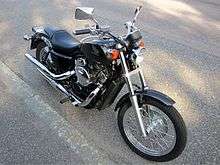
The "VT750C" also introduced in 1983 with the VT500c. Special identifying features of this model are the round head lamp, instrument casings and the chromed front fender. The backrest was standard equipment. The painted side covers had the "Shadow 750" decal. The engine is a 749 cc (45.7 cu in) SOHC 3-valve Liquid Cooled V-Twin with a six-speed shaft drive transmission.[8] The VT750C Shadow was still available in Canada for 1984 as U.S. tariffs do not apply there. Subsequent years, only the VT700C was available.
The "VT700C" was introduced in 1984 as a direct result of increased tariffs placed on Japan's imports. The U.S. raised the import tariffs on engine sizes above 701 cc (42.8 cu in). So the engine size was reduced from a 750 cc (46 cu in) to 700 cc (43 cu in) to get the bikes into the U.S.[9] Special identifying features of this model are the round head lamp and instrument casings with a chromed front fender. The front wheel bore a dual disc brake system and dual horns mounted on the front. The painted side covers had the "Shadow 700" decal. The engine is a 694 cc (42.4 cu in) SOHC three-valve Liquid Cooled V-Twin with a six-speed, shaft drive transmission from 1984 to 1987. New hydraulic valve adjusters and twin plug cylinder heads were used. The "VT750C" was available outside of the USA (Canada and Europe) with a larger engine displacement.
In 1985, The "VT700C" model featured polished chrome engine side covers. The engine is the same as the 1984 model year. The "VT750C" was available outside of the USA (Canada and Europe) with a larger engine displacement.
In 1986, The "VT700C" model rear fender took on a flair look over the rounded style. The engine is the same as the 1984 model except polished instead of black with the right engine cover graphic painted black. The mufflers were a little lower and changed from the flair look to a more straight style. The front pegs and controls were moved forward, the rear foot peg support bracket became solid and the back rest was optional this year. The cast wheels changed from a ten-spoke to a five-spoke design and the access covers were chromed. The "VT750C" was available outside of the USA (Canada and Europe) with a larger engine displacement.
The 1987 "VT700C" model featured the same engine as the 1986 model but with the right engine cover graphic not painted. The side covers are chrome, five-spoke cast wheels with a single front disc brake.
The "VT750C" was available outside of the USA (Canada and Europe) with a larger engine displacement.
Honda created an 800cc model by increasing the stroke of the 750 engine by 5.1 millimeters. Dubbed the "VT800C", it was produced only for the 1988 model year.[10] Along with the engine upgrade, the VT800C had additional chrome plating, spoked wheels (requiring tube-type tires) and a transmission downgraded to four speeds.[5]
In 2004, the VT750C Shadow Aero was redesigned with larger valenced fenders to give it more of a retro look. It also moved from chain drive to a sealed shaft drive which decreases the amount of required maintenance. As for the engine, it remained a V-Twin but included 2 spark plugs per cylinder to increase efficiency. It also got rid of the second carb so only a single carb feeds the engine with fuel.[11]
Between 2010 and 2013, a restyled VT750RS / Shadow RS (VT750S outside of North America) with an O-ring-sealed chain final drive joined the heavier Shadow Phantom, Aero and Spirit 750 shaft-drive models.[12][13] Curb weight was 232 kg (511 lb).
VT750C recall
Honda and NHTSA issued a January 2016 recall for 2010 through 2016 VT750C/CA/CS, VT750C2/ C2F/C2S, and VT750C2B models.[14] The NHTSA announcement said that “engine vibration may cause the bank angle sensor wire to rub on the wire harness joint connector, resulting in a loss of the sensor signal.” Honda Motor Company had received reports, dating back to 2013, of engine stall or misfire incidents resulting from bank angle sensor failure.[15]
VT400 replica
Honda Japan created a series of VT400 (in Japanese) models for the Japanese domestic market in 1997, practically identical to the VT750 series but with smaller displacement engines. Among these was the Shadow Slasher, introduced in February 2000.[16][17][18] From 2009, Honda Australia imports the VT400 as a Learner Approved Motorcycle alongside the popular VT750.[19]
1,100 cc VT Class
The V-Twin 1100 (VT1100) was introduced by Honda in 1985 and was in continuous production till 2007.
All models used the same Honda VT1100 engine with minimal mechanical changes during its production.
1985
The VT1100C model was introduced in 1985 as a larger model from the 750/800cc models. A quick visual indicator of the '85-'86 model is dual horns located on the front below the headlight, turning indicators are square shaped, and one exhaust pipe on each side (front cylinder on right side, rear cylinder on left). Fuel and temperature gauges are located on the tank. The engine is a 1,099 cc (67.1 cu in) SOHC Liquid Cooled V-twin with a five-speed, shaft drive transmission.
1987
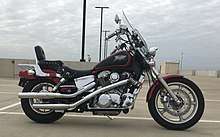
The 1987 VT1100C model took on a brand-new look with a lower seat (26-inch-high (660 mm)), a longer wheelbase 65-inch (1,700 mm), a 3.44 US gallons (13.0 l; 2.86 imp gal) fuel tank, and an 41 millimetres (1.6 in) extended front fork design. Both exhaust pipes were now run along the right side of the bike, with the horns being relocated to the sides of the engine.
The engine is virtually identical to the previous model, but now has a four-speed transmission with a hydraulicly actuated clutch.
The "VT1100C" model was not manufactured in 1991 (to sell off excess stock of 1990 models), but returned in 1992 with a "Made in the USA" stamp on the seat.
Visually, the VT1100C matched most of the styling cues of the Harley-Davidson FXDWG. This styling continued through 1996.
1986 was the last year of the high performance v-twin 1100 which made approximately 76 horsepower. It had a longer stroke and smaller piston compared to the 1987 1100 which had almost 20 horsepower less due to larger piston and shorter stroke.
American Classic Edition (A.C.E.)
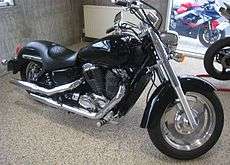
In 1995, the V-Twin market really got going, and manufacturers expanded their offerings with variants of their standing models.
The American Classic Edition (A.C.E.) (VT1100C2) was introduced this year. It featured a more retro styling than the standard with a full rear fender, induced vibrations, and 'Harley-Davidson-like' sound from a single pin crank engine. The model also lost about 10 hp.
1997
1997 saw the Standard replaced with the Spirit with more chrome on the engine but the same basic engine as the standard. An ACE Tourer was also introduced based on the 1100 Spirit engine but the ACE styling. The ACE Tourer came with a two-into-one-into-two exhaust system and hard, color-matched saddlebags. The last of the 6,000+ Tourer models was produced in January 2001.
1998
In 1998 Honda rolled out the VT1100C3 Aero, based on the VT1100C2 ACE engine with the single pin crank, but a larger two into one exhaust and more retro styling. The 1100 Aero was discontinued after the 2003 model year.
2000
The Honda Shadow Sabre model was introduced, based on the Honda VT1100 engine with different styling than the Spirit model. The most notable feature was the front cast aluminum wheel. This model also had a slightly lower rear gear ratio in the shaft drive allowing this to have better off the line acceleration than the regular Spirit model.
Due to lower sales and the availability of the VTX1300, 2007 was the final year Honda made the VT1100 Shadow.
Notes
- ↑ Roberts, Tim (2 September 2003). "Shadow Aero" (DOC). Honda News. Torrance, CA: Honda North America. Retrieved 13 October 2018.
- ↑ "Technical Information". 2005 Honda VT750C Shadow Aero Owner's Manual (PDF). Honda Motor Co. 2004. pp. 177–188. Retrieved 10 October 2018.
- ↑ "2018 Honda Shadow Aero Specifications". Honda News. Torrance, CA: Honda North America. 6 November 2017. Retrieved 13 October 2018.
- ↑ "Motorcycle product news". Honda Press Information (in Japanese). Tokyo: Honda Motor Co. 16 December 1982. Retrieved 14 October 2018.
(translation) Liquid-cooled 4-stroke, SOHC 3 valves, 45-degree V-twin engine American-style sports bike Honda NV750 custom launches
- 1 2 3 Salvadori, Clement (17 April 2017). "Retrospective: 1988 Honda VT800C Shadow". Rider Magazine. Camarillo: EPG MEDIA. Retrieved 8 October 2018.
However, when the ’89 model year rolled around, the only VT on the showroom floor was the 1100.
- ↑ "General Information". Shop Manual Shadow VT700C VT750C (PDF). Honda Motor Co. September 1984. pp. 1‑3 – 1‑4. Retrieved 10 October 2018.
- ↑ "General Information". Service Manual 86-87 VT700C Shadow (PDF). Honda Motor Co. December 1986. pp. 1‑3 – 1‑4. Retrieved 10 October 2018.
- ↑ "VT750C Road Test". Cycle. 1982. Archived from the original on 5 July 2005. Retrieved 9 October 2018.
- ↑ "Honda VT700C". CycleChaos. 28 November 2010. Retrieved 9 October 2018.
- ↑ Virgil, Jim (16 February 1989). "MOTORCYCLE MARKET REVVING UP". Chicago Tribune. Retrieved 9 October 2018.
Therefore the Hurricane 1000 sportbike; the 800 Shadow, which had been a challenger to the Harley-Davidson Sportster; and the Magna 750 are gone.
- ↑ Freund, Ken (January 29, 2004). "2004 Honda Shadow Aero VT750 Road Test". Rider. Archived from the original on March 20, 2013.
- ↑ Blake, Adrian (25 March 2010). "Honda powers into 2010". Owen Sound Sun Times. Retrieved 14 February 2014.
'The RS is Honda's attempt to break the mould of the cruiser design in Honda's 750 cc segment, like the Fury did for the 1300s.' says senior product manager Warren Milner.
- ↑ Bond, Steve (13 March 2010). "Honda's Shadow RS beats cruiser rap". Wheels.ca. Toronto Star Newspapers Limited. Retrieved 14 February 2014.
The 'RS' stands for 'retro standard' and that sums it up perfectly. It’s not really a standard, it’s certainly not a sportbike and it’s not really a cruiser either.
- ↑ "SAFETY RECALL: 2010-2016 VT750 Bank Angle Sensor Replacement" (PDF). OEMDTC.com. American Honda Motor Co. 19 January 2016. Retrieved 13 October 2018.
- ↑ Wilson, Bryon (13 January 2016). "Honda Recalls 22,142 Shadow Cruiser Models". MotoUSA.com. Medford, Oregon: Motorcycle USA. Retrieved 8 October 2018.
- ↑ "ホンダ シャドウスラッシャー(2000年モデル)の歴史" [History of the Honda Shadow Slasher (Year 2000 model)]. bbb-bike.com. Retrieved 12 August 2018.
- ↑ "ホンダ シャドウスラッシャー のカラーリングを変更" [Update to colouring of Honda Shadow Slasher]. Response. 29 November 2004. Retrieved 12 August 2018.
- ↑ "Mazda lets buyers fine-tune Roadster". Japan Times. 5 January 2002. Retrieved 12 August 2018.
- ↑ Hinchliffe, Mark (22 August 2009). "Learners retain some cred on Honda VT400". Australian. Retrieved 14 February 2014.
External links
| Wikimedia Commons has media related to Honda Shadow. |